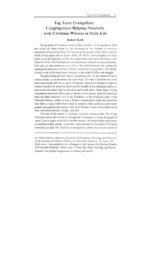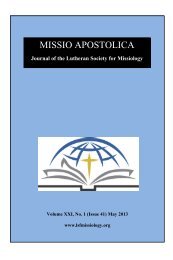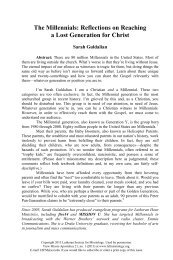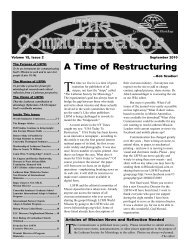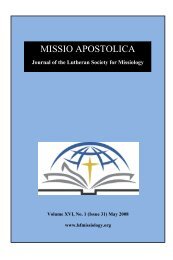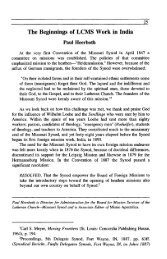The Concept of Life and Death in Christian Martyrdom in Japan
The Concept of Life and Death in Christian Martyrdom in Japan
The Concept of Life and Death in Christian Martyrdom in Japan
- No tags were found...
Create successful ePaper yourself
Turn your PDF publications into a flip-book with our unique Google optimized e-Paper software.
<strong>The</strong> Conce~t <strong>of</strong> <strong>Life</strong> <strong>and</strong> <strong>Death</strong> 1 t<br />
<strong>The</strong> <strong>Concept</strong> <strong>of</strong> <strong>Life</strong> <strong>and</strong> <strong>Death</strong> <strong>in</strong><br />
<strong>Christian</strong> <strong>Martyrdom</strong> <strong>in</strong> <strong>Japan</strong><br />
Chizuo Shibata<br />
Introduction<br />
<strong>The</strong> year 1997 marked the 400th anniversary <strong>of</strong> the 26 <strong>Christian</strong> martyrs <strong>in</strong><br />
Nagasaki. This has stimulated a renewed <strong>in</strong>terest <strong>in</strong> the study <strong>of</strong> the Kirzshitan Era (the<br />
first <strong>Christian</strong> era <strong>in</strong> <strong>Japan</strong>). Though this may be <strong>of</strong> <strong>in</strong>terest especially to historians,<br />
missiologists should not by any means overlook this period. For example, Alex<strong>and</strong>ra<br />
Valignano, Jesuit Visitor who was to represent <strong>in</strong> the East India Diocese <strong>of</strong> the Society <strong>of</strong><br />
Jesus (the Jesuit Order), had visited <strong>Japan</strong> three times, <strong>and</strong> exhibited unusual leadership<br />
<strong>in</strong> mission strategy. All his activity calls for serious attention even today.<br />
I am <strong>of</strong> the op<strong>in</strong>ion that almost all mission problems extant <strong>in</strong> this country had<br />
already come to the surface dur<strong>in</strong>g his stay <strong>of</strong> more than two years each time he visited<br />
<strong>Japan</strong> for the <strong>of</strong>ficial <strong>in</strong>spection <strong>of</strong> Jesuit work. He already left <strong>Japan</strong> for good by the time<br />
the Tokugawa Govenunent adopted the systematic cont<strong>in</strong>ual persecution policy aga<strong>in</strong>st<br />
<strong>Christian</strong>ity which was eventually carried out publicly <strong>in</strong> 1614, <strong>and</strong> forced almost all<br />
missionaries <strong>and</strong> faithful <strong>Japan</strong>ese out <strong>of</strong> <strong>Japan</strong> to Macao <strong>and</strong> Luzon <strong>in</strong> the Philipp<strong>in</strong>es.<br />
But Visitor Valignano had already seen some symptoms <strong>of</strong> an impendmg disastrous<br />
persecution period. For that reason he endeavored to <strong>in</strong>itiate some preparatory tra<strong>in</strong><strong>in</strong>g<br />
for the <strong>Christian</strong>s to meet the com<strong>in</strong>g crises. From the rnissiological po<strong>in</strong>t <strong>of</strong> view I<br />
believe that <strong>in</strong> his report Sumario de la cosas de Japon (Report <strong>of</strong> Inspection <strong>of</strong> <strong>Japan</strong>),<br />
all mission issues <strong>and</strong> problems we face today were already dealt with by him.<br />
His report is a priceless resource for gett<strong>in</strong>g a better underst<strong>and</strong><strong>in</strong>g <strong>of</strong> the mission<br />
history <strong>of</strong> <strong>Japan</strong>. We tend to th<strong>in</strong>k ma<strong>in</strong>ly <strong>of</strong> Europe <strong>and</strong> Reformation history when<br />
talk<strong>in</strong>g about the church's work <strong>in</strong> the 16' <strong>and</strong> 17" centuries. It is, however, an amaz<strong>in</strong>g<br />
fact that <strong>in</strong> those very centuries, <strong>in</strong> this Far East part <strong>of</strong> the world a most significant<br />
<strong>Christian</strong> movement had been <strong>in</strong>itiated which produced abundant fruit, a m<strong>in</strong>imum <strong>of</strong><br />
400,000 converts, who were eventually almost all exterm<strong>in</strong>ated through heartlessly fierce<br />
persecutions. <strong>Christian</strong> history books need to be revised to <strong>in</strong>clude an impartial<br />
evaluation <strong>of</strong> that era. Of course, the mission enterprise <strong>of</strong> the Jesuits those days were<br />
<strong>The</strong> Rev. Chizuo Shibata D.D., Litt.D., served as an orda<strong>in</strong>ed pastor <strong>of</strong> the <strong>Japan</strong><br />
Lutheran Church for more than 43 years as its president, 1974-1978, as pr<strong>of</strong>essor at the<br />
Tokyo Lutheran College <strong>and</strong> Sem<strong>in</strong>ary s<strong>in</strong>ce 1978. Dr. Shibata has recently been<br />
appo<strong>in</strong>ted by his church body to explore <strong>and</strong> develop mission among the <strong>Japan</strong>ese <strong>in</strong> the<br />
United States.
12 Missio Apostolica<br />
undeniably an after effect <strong>of</strong> the Reformation Movement, <strong>and</strong> the conflicts between two<br />
powers <strong>in</strong> the Iberian Pen<strong>in</strong>sula were reflected <strong>in</strong> the mission history <strong>of</strong> that era as well.<br />
Current study reveals the fact that the missionaries <strong>of</strong> that time seriously debated the<br />
feasibility <strong>and</strong> propriety <strong>of</strong> a military conquest <strong>of</strong> this nation, which should then be<br />
followed by evangelism among the colonized people just as had been done <strong>in</strong> other parts<br />
<strong>of</strong> the world <strong>in</strong> the period <strong>of</strong> colonialism. At the same time, it should be po<strong>in</strong>ted out that<br />
those who accepted <strong>Christian</strong>ity will<strong>in</strong>gly, llke some feudalistic local lords, had secret<br />
desires to become superior to other lords through procur<strong>in</strong>g various weapons from the<br />
missionaries, or by promot<strong>in</strong>g trade through the mission society, which hctioned as a<br />
k<strong>in</strong>d <strong>of</strong> trad<strong>in</strong>g agency for susta<strong>in</strong><strong>in</strong>g their mission work f<strong>in</strong>ancially.<br />
<strong>in</strong> this respect, the mission strategy <strong>of</strong> that time is quite different from that <strong>of</strong> today,<br />
<strong>and</strong> it may have seemed to them that there was no other way. For example, it took them<br />
about two years to get a response to a specific letter to ask for authorization to implement<br />
a mission policy. Valignano decided to ask the Pope not to permit any other societies to<br />
get <strong>in</strong>to mission work <strong>in</strong> <strong>Japan</strong> except the Jesuits, because <strong>of</strong> his fear that otherwise the<br />
<strong>Japan</strong>ese people might be misled to believe that even <strong>Christian</strong>ity is a pantheistic faith<br />
with many different groups <strong>and</strong> beliefs. But before he received the answer from the Pope,<br />
who recognized the validity <strong>of</strong> his request, other societies llke the Franciscans or<br />
Dom<strong>in</strong>icans entered <strong>Japan</strong> from Luzon <strong>and</strong> brought the seeds <strong>of</strong> chaotic conflict among<br />
the <strong>Christian</strong> groups <strong>in</strong> this country <strong>and</strong> thus contributed to the creation <strong>of</strong> a negative<br />
attitude toward <strong>Christian</strong>ity on the part <strong>of</strong> <strong>Japan</strong>ese people.<br />
Because <strong>of</strong> this <strong>and</strong> similar problems related to slow communication <strong>in</strong> those years,<br />
each mission society had to work out its own self-support methods, whch <strong>in</strong>evitably<br />
became mixed up with secular bus<strong>in</strong>ess <strong>and</strong> political powers. However, what is most<br />
important historically is the fact that <strong>Japan</strong> <strong>and</strong> the <strong>Japan</strong>ese people for the first time<br />
encountered <strong>Christian</strong>ity, <strong>and</strong> through this encounter the true nature <strong>and</strong> religious<br />
characteristics <strong>of</strong> this people were revealed through the way they dealt with it. And on the<br />
part <strong>of</strong> the <strong>Christian</strong> <strong>Japan</strong>ese it was also the first time to come across an organizationally<br />
well-ordered, established religion. <strong>Christian</strong>ity took root deeply <strong>in</strong> the lives <strong>of</strong> the people.<br />
<strong>The</strong>ir enthusiastic but serious response was so different from the experiences those early<br />
missionaries had had <strong>in</strong> various other places before com<strong>in</strong>g to <strong>Japan</strong>.<br />
Consequently, the Tokugawa Government had implemented a stem Exclusion Policy<br />
(Raen) by which <strong>Christian</strong>ity was systematically <strong>and</strong> cont<strong>in</strong>uously banned <strong>and</strong><br />
persecuted. In other words, <strong>Japan</strong> drastically changed political direction as she<br />
encountered <strong>Christian</strong>ity for the frrst time. This change had a very significant effect on<br />
her life <strong>and</strong> culture. Another historic policy related to this anti-<strong>Christian</strong> policy was the<br />
Religzous Registration Decree accord<strong>in</strong>g to which all <strong>Japan</strong>ese people were ordered to<br />
register <strong>in</strong> a Buddhist temple nearest to their residence, as a member <strong>of</strong> that temple.<br />
Undoubtedly this was carried out to f<strong>in</strong>d out who were the <strong>Christian</strong> believers.<br />
This Religious Registration Decree succeeded <strong>in</strong> establish<strong>in</strong>g a close tie between<br />
family <strong>and</strong> temple (Danka <strong>and</strong> Danna-dera). This stem policy eventually but successfully<br />
drove the surviv<strong>in</strong>g <strong>Christian</strong>s to carry on their activities underground. This approach <strong>in</strong><br />
itself gave the populace a faulty impression <strong>and</strong> resulted generally <strong>in</strong> a deep-rooted
<strong>The</strong> <strong>Concept</strong> <strong>of</strong> <strong>Life</strong> <strong>and</strong> <strong>Death</strong> 13<br />
negative attitude toward <strong>Christian</strong>ity. <strong>The</strong> Danka-Danna-dera system contributed to<br />
mak<strong>in</strong>g rel~gious faith a matter <strong>of</strong> corporate belief (family-temple belief) rather than that<br />
<strong>of</strong> each <strong>in</strong>dividual person. <strong>Japan</strong>ese religions ma<strong>in</strong>ly are based on this religiously united<br />
family belief which one may refer to as "traditional religion."<br />
Consequently, many <strong>Japan</strong>ese <strong>Christian</strong>s had to make a serious choice: face<br />
martyrdom or apostasy. It is at this po<strong>in</strong>t that it becomes clear that true religion <strong>and</strong><br />
commitment to it could not be considered without deal<strong>in</strong>g with the problem <strong>of</strong> death.<br />
That aspect <strong>of</strong> religion dist<strong>in</strong>guishes it from ethics or philosophy. However, death by<br />
martyrdom is not the same as death which comes naturally at the end <strong>of</strong> any person's life.<br />
By contrast, martyrdom is the negation <strong>of</strong> apostasy. A martyr faces death <strong>of</strong> his or her<br />
own will even when that death could be avoided. So the crucial factor is one's own<br />
decision. Some may have an immovable will. Others may be falter<strong>in</strong>g. But martyrdom<br />
does not occur without a decision. A way <strong>of</strong> apostasy is usually <strong>of</strong>fered <strong>in</strong> the time <strong>of</strong> any<br />
persecution. <strong>The</strong> literature <strong>of</strong> Shusaku Endo, for example, was created from thls very<br />
dilemma: choose martyrdom or apostasy! At any rate there is much to be ga<strong>in</strong>ed from a<br />
study <strong>of</strong> that era not only for historians, but also for pastors <strong>and</strong> evangelists for ga<strong>in</strong><strong>in</strong>g a<br />
better underst<strong>and</strong><strong>in</strong>g <strong>of</strong> <strong>Japan</strong> <strong>and</strong> the <strong>Japan</strong>ese people.<br />
I. <strong>Martyrdom</strong> <strong>in</strong> Biblical Times<br />
In analyz<strong>in</strong>g martyrdom, what about the person who dies for the <strong>Christian</strong> faith,<br />
while fight<strong>in</strong>g with weapons That cannot be called a true martyrdom. Consider a case <strong>in</strong><br />
pc<strong>in</strong>t from <strong>Japan</strong>ese hlstory, namely the Shmabara Revolt (1637-1638) dur<strong>in</strong>g the<br />
Tokugawa regime.<br />
Today, scholars' op<strong>in</strong>ions vary <strong>in</strong> their <strong>in</strong>terpretation <strong>of</strong> this conflict. Was it a<br />
farmers' revolt, or a religious (<strong>Christian</strong>) revolt If we take the latter <strong>and</strong> call it a holy<br />
war, those people killed <strong>in</strong> the battle cannot be called martyrs, s<strong>in</strong>ce they fought with<br />
weapons. This is the <strong>of</strong>f~cii position <strong>of</strong> the Roman Church, that is, 'knartyrdom" is the<br />
death that comes when one rema<strong>in</strong>s loyal to the end for the sake <strong>of</strong> the holy teach<strong>in</strong>g. <strong>The</strong><br />
true life is <strong>in</strong> the teach<strong>in</strong>g. One does not lose the true life even when lulled for the sake <strong>of</strong><br />
the holy teach<strong>in</strong>g. In that circumstance one does not have to fight with weapons to save<br />
the true life.<br />
In this sense, are there any examples <strong>of</strong> martyrdom <strong>in</strong> the Bible To refer to Jeremiah<br />
as a martyr is justifiable. Jeremiah, who had been persecuted for many years, was,<br />
accord<strong>in</strong>g to tradition, stoned to death by his fellow countrymen while exiled <strong>in</strong> Egypt.<br />
However, the cases which are most similar to the martyrdoms which occurred <strong>in</strong> <strong>Japan</strong><br />
are found <strong>in</strong> the Apocrypha. For example, the martyrdoms <strong>of</strong> Eleazar, <strong>and</strong> also the seven<br />
brothers with their mother, which are reported <strong>in</strong> the 6" <strong>and</strong> 7' chapters <strong>of</strong> Second<br />
Maccabees. In both <strong>in</strong>stances, these devout Jews refused to eat pork <strong>and</strong> out <strong>of</strong> deep<br />
commitment to their religious pr<strong>in</strong>ciples will<strong>in</strong>gly endured torture <strong>and</strong> cruel death. <strong>The</strong>se<br />
examples are similar to the notorious methods <strong>of</strong> persecution used <strong>in</strong> <strong>Japan</strong>, when<br />
suspected <strong>Christian</strong>s were compelled to step on the fumie (the image) <strong>of</strong> the Virg<strong>in</strong> Mary<br />
<strong>in</strong> order to prove one's self to be non-<strong>Christian</strong>, or else suffer torture <strong>and</strong> death.
14 Mcssio Apostolica<br />
If those martyrs had but simply laid aside their traditional way <strong>of</strong> life, few would<br />
have accused them <strong>of</strong> be<strong>in</strong>g cowards. However, <strong>in</strong> read<strong>in</strong>g I1 Maccabbees, many<br />
<strong>Japan</strong>ese are <strong>in</strong>evitably rem<strong>in</strong>ded <strong>of</strong> many stories related to the atrocious persecution that<br />
broke out <strong>in</strong> the 16' <strong>and</strong> 17' centuries. <strong>The</strong>re is someth<strong>in</strong>g common <strong>in</strong> both cases: be<strong>in</strong>g<br />
faithful without compromise, without violence, faithful unto death.<br />
In the New Testament the classic example <strong>of</strong> Stephen comes to m<strong>in</strong>d. His case is<br />
sharply different fiom that <strong>of</strong> the Maccabbees. For his torturers he cried out a prayer,<br />
"Lord, do not hold h s s<strong>in</strong> aga<strong>in</strong>st them" (Acts 7:60). Stephen bore witness (marturia) to<br />
his faith <strong>in</strong> Jesus Christ. This po<strong>in</strong>t is crucial. <strong>The</strong> English word "martyrdom" comes<br />
from the Greek marturia which orig<strong>in</strong>ally does not connote rhe same mean<strong>in</strong>g as it is<br />
used <strong>in</strong> English today. Its <strong>in</strong>herent mean<strong>in</strong>g is to be a witness. Yet, it is easy to see how<br />
the term "martyr" took on the mean<strong>in</strong>g <strong>of</strong> a person who dies for his convictions.<br />
In the New Testament Jesus <strong>of</strong>ten called his disciples his witnesses, <strong>and</strong> <strong>in</strong>deed, they<br />
attested to his death <strong>and</strong> resurrection (Luke 24:48; Acts 1:8, etc.). <strong>The</strong>y likewise referred<br />
to themselves as witnesses (Acts 2:32; 3:15; 5:32). Faithful witness<strong>in</strong>g <strong>of</strong>ten led to<br />
persecution, as was predicted <strong>in</strong> Matthew 10: 17-18. That passage became very important<br />
for the <strong>Japan</strong>ese <strong>Christian</strong>s dur<strong>in</strong>g the persecution period. <strong>The</strong>y knew that faithiid<br />
followers <strong>of</strong> Christ were called witnesses even before the term "Chnstian" became<br />
popular (Acts 11:26). Dr. Arirnichi Ebisawa, one <strong>of</strong> the pioneer scholars <strong>of</strong> the<br />
"Kirishitan" Era <strong>in</strong> the persecution periods, said <strong>in</strong> effect that s<strong>in</strong>ce ancient times it is the<br />
nature <strong>of</strong> faithful <strong>Christian</strong>s to openly witness their<br />
commitment to Christ.<br />
In that sense the <strong>Japan</strong>ese <strong>Christian</strong>s <strong>in</strong> the persecution period followed the pattern<br />
left by Christ's disciples, who understood also the Old Testament concepts <strong>of</strong> witness <strong>and</strong><br />
w~tness<strong>in</strong>g, "one who emphatically <strong>and</strong> repeatedly affms a testimony." <strong>The</strong>y<br />
concentrated on proclaim<strong>in</strong>g the Good News that Jesus dled for all, "so that those who<br />
live should no longer to live for themselves, but for him who died for them <strong>and</strong> was<br />
raised aga<strong>in</strong>. . . . <strong>The</strong>refore if anyone is <strong>in</strong> Christ, he is a new creation; the old has gone.<br />
<strong>The</strong> new has come!" (2 Cor. 5:15-17).<br />
11. An Assessment <strong>of</strong> the Persecution Era <strong>in</strong> the Early <strong>Christian</strong> Era <strong>in</strong><br />
<strong>Japan</strong><br />
To most <strong>Japan</strong>ese people today, the word Junkyou, "<strong>Martyrdom</strong>," is unfamiliar, a<br />
word from a distant past. Actually, they live <strong>in</strong> a society where legally martyrdom would<br />
hardly take place. It is someth<strong>in</strong>g they do not underst<strong>and</strong> from personal experience.<br />
Religious persecution may break out, but its perpetrators could be subject to legal<br />
prosecution. However, we should not forget the history, not far distant from today, for<br />
example that <strong>of</strong> Nazi Germany's or <strong>Japan</strong>'s imperialism, when <strong>in</strong>tentionally governments<br />
closed their eyes to such violence which broke out <strong>and</strong> destroyed basic human rights <strong>and</strong><br />
freedom. Humank<strong>in</strong>d still has an <strong>in</strong>herent weakness to repeat the same errors <strong>of</strong> the past.<br />
However, even the history <strong>of</strong> the Kirishitan Jidai (persecution period) was not totally<br />
ta<strong>in</strong>ted by brutal persecution stories. Nor can we place total blame for these persecutions
<strong>The</strong> <strong>Concept</strong> <strong>of</strong> <strong>Life</strong> <strong>and</strong> <strong>Death</strong> 15<br />
-<br />
on the society <strong>of</strong> that era, while imply<strong>in</strong>g that the churches were all immune <strong>and</strong> free<br />
from mistakes or even corruption. This is what makes history complicated. This will<br />
become clear <strong>in</strong> exam<strong>in</strong><strong>in</strong>g <strong>in</strong> greater detail the background <strong>of</strong> the martyrdom <strong>of</strong> the 26<br />
sa<strong>in</strong>ts <strong>in</strong> Nagasaki <strong>in</strong> 1597.<br />
At first, 160 <strong>Christian</strong>s were arrested, but an <strong>of</strong>ficial, Mitsumari Ishida, a<br />
sympathizer <strong>of</strong> the <strong>Christian</strong>s, had reduced the number <strong>of</strong> apprehended persons down to<br />
24. Most <strong>of</strong> them were arrested <strong>in</strong> Kyoto, <strong>and</strong> they had part <strong>of</strong> their ears cut <strong>of</strong>f <strong>and</strong> were<br />
forced to parade through the streets <strong>of</strong> Kyoto as a warn<strong>in</strong>g to the people <strong>of</strong> that city. <strong>The</strong>n<br />
they were brought to Sakai, a commercial seaport. From there, they were forced to travel<br />
on foot all the way down to Nagasaki, almost 500 miles <strong>in</strong> bitter w<strong>in</strong>ter weather. <strong>The</strong><br />
forced march took more than a month. En route, two others jo<strong>in</strong>ed them <strong>of</strong> their own will.<br />
So all together there were 26 believers, <strong>in</strong>clud<strong>in</strong>g 6 foreign missionaries.<br />
<strong>The</strong>y were executed immediately when they arrived <strong>in</strong> Nagasaki, on Nishisaka, a hill<br />
overlook<strong>in</strong>g the town. <strong>The</strong>ir dead bodies were left on the crosses for many days as<br />
described <strong>in</strong> a novel by Akira Yoshimura, a prom<strong>in</strong>ent writer <strong>in</strong> <strong>Japan</strong> today. This was<br />
undoubtedly true martyrdom. Everybody would be impressed by their courageous<br />
witness. But historically it is important to note that this martyrdom took place <strong>in</strong> the<br />
regime <strong>of</strong> Hideyoshi, not <strong>in</strong> the regime <strong>of</strong> Ieyasu, the one who vigorously <strong>and</strong><br />
systematically applied the persecution policy aga<strong>in</strong>st the <strong>Christian</strong>s. It is not my <strong>in</strong>tent to<br />
detract from the heroic witness <strong>of</strong> those martyrs <strong>in</strong> Nagasaki, but it is necessary to po<strong>in</strong>t<br />
out the fact that there was some attendant political conflict which had broken out between<br />
Hideyoshi <strong>and</strong> the representatives <strong>of</strong> Spanish political expansionism as well as a related<br />
contention between the Jesuits <strong>and</strong> the Franciscans.<br />
It has to be noted that not a s<strong>in</strong>gle Jesuit was among those martyred missionaries.<br />
<strong>The</strong>y were all Franciscans. <strong>The</strong>ir mission started <strong>in</strong> <strong>Japan</strong> 40 years after the Jesuits. In<br />
that sense they were still newcomers, <strong>and</strong> yet it was only they who met th~s cruel death.<br />
No doubt, related to the conflict<strong>in</strong>g political <strong>and</strong> economic <strong>in</strong>terests <strong>of</strong> Spa<strong>in</strong> <strong>and</strong> Portugal<br />
there was a k<strong>in</strong>d <strong>of</strong> related conflict between the two mission bodies. Just ten years before<br />
this martyrdom, <strong>in</strong> 1587, Hideyoshi had abruptly issued a decree, called Bateren-tsuiho-<br />
Rei (Order <strong>of</strong> Expulsion) <strong>of</strong> all missionaries, dem<strong>and</strong><strong>in</strong>g them all to depart <strong>Japan</strong> with<strong>in</strong><br />
20 days. <strong>The</strong> ramifications <strong>of</strong> this decree are quite controversial. Even today scholars<br />
disagree as to what might have been Hideoshi's true <strong>in</strong>tent for the decree. However,<br />
Alex<strong>and</strong>ro Valignano, the Jesuit Visitor <strong>of</strong> the East Asia Diocese, had criticized Viceprov<strong>in</strong>cial<br />
Coelho's thoughtless action as a cause <strong>of</strong> Hideyoshi's sudden change <strong>in</strong><br />
attitude to the <strong>Christian</strong> mission. Coelho tried to please Hideyoshi by assur<strong>in</strong>g him <strong>of</strong><br />
Portuguese anned ships for assist<strong>in</strong>g him <strong>in</strong> the wars aga<strong>in</strong>st the feudal lords <strong>in</strong> Kyushu<br />
<strong>in</strong> his efforts to unify war- tom <strong>Japan</strong>, as well as his plan to <strong>in</strong>vade Korea <strong>and</strong> Ch<strong>in</strong>a.<br />
Such flatter<strong>in</strong>g remarks by a man <strong>in</strong> a higher position <strong>of</strong> a religious order naturally<br />
revealed his proud attitude <strong>of</strong> superiority over aga<strong>in</strong>st <strong>Japan</strong> <strong>and</strong> thereby created grounds<br />
for suspicion on the part <strong>of</strong> Hideyoshi-especially about any possible ulterior motives<br />
that might be woven <strong>in</strong>to the <strong>Christian</strong> work be<strong>in</strong>g done <strong>in</strong> <strong>Japan</strong> at that time. This to me<br />
appears to be a fair judgment.
16 Missio Apostolica<br />
Although Hideyoshi did not strictly carry out this decree, it did undoubtedly give<br />
impetus to his successor Ieyasu, who established the Tokugawa dynasty which lasted for<br />
almost three centuries. He hated <strong>Christian</strong>ity, <strong>and</strong> it was he who apenly started<br />
persecutions. Thus Hideyoshi's decree was f<strong>in</strong>ally implemented <strong>in</strong> the Tokugawa regime.<br />
It was this decree that eventually brought about a drastic turn <strong>in</strong> the former more tolerant<br />
policies <strong>of</strong> the rul<strong>in</strong>g warrior class. Now organized <strong>and</strong> cont<strong>in</strong>uous persecutions were<br />
tak<strong>in</strong>g shape. In any given society also churches are not always immune to faults or to<br />
mak<strong>in</strong>g unwise judgments. This is a lesson that can be learned from the persecution era.<br />
In 1614, Hideyoshi's expulsion order was f<strong>in</strong>ally carried out, <strong>and</strong> almost all missionaries<br />
were forced to leave <strong>Japan</strong> for Macao <strong>and</strong> Luzon, while some rema<strong>in</strong>ed secretly to<br />
cont<strong>in</strong>ue "car<strong>in</strong>g for the sheep."<br />
As a result <strong>of</strong> this coercive measure <strong>of</strong> the Tokugawa Regime, the history <strong>of</strong> <strong>Japan</strong>'s<br />
<strong>Christian</strong> churches entered a completely new chapter, the bitterly brutal persecution era,<br />
called by Shusaku Endo "the third stage" <strong>of</strong> the kirishitan Jidai (<strong>Christian</strong> Era). <strong>The</strong> f<strong>in</strong>al<br />
stage is known as the "Hidden <strong>Christian</strong> Era," the era when the Chstians did not have<br />
pr<strong>of</strong>essional leaders. Endo is one <strong>of</strong> the most prom<strong>in</strong>ent <strong>Christian</strong> writers <strong>in</strong> modem<br />
<strong>Japan</strong>. His historical novel Chimmoku (Silence) has been translated <strong>in</strong>to many other<br />
languages <strong>and</strong> is widely read over the world. In his essay "In the Swamp <strong>of</strong> <strong>Japan</strong>" Endo<br />
says that enter<strong>in</strong>g this third stage (1614) <strong>of</strong> the Kirishitan Jidai, <strong>Japan</strong>ese Chnstians stood<br />
at the cross-roads, faced with the dilemma to choose apostasy or martyrdom. This stage<br />
ended with the Shirnabara revolt <strong>in</strong> 1637-1638. Many <strong>Christian</strong>s who jo<strong>in</strong>ed <strong>in</strong> this revolt<br />
aga<strong>in</strong>st the Tokugawa Regime were killed. On the surface, <strong>Christian</strong>ity disappeared <strong>and</strong><br />
the last stage <strong>of</strong> the era started. <strong>Christian</strong> people who survived the persecutions had to<br />
pretend to be non-<strong>Christian</strong>s or Buddhists <strong>in</strong> order to keep up their faith secretly. <strong>The</strong>y<br />
are called Kakure-Kirishitan (Hidden <strong>Christian</strong>s).<br />
<strong>The</strong>y were not formally organized, but isolated from one another without any<br />
pr<strong>of</strong>essional leaders.<br />
III. <strong>Life</strong> <strong>and</strong> <strong>Death</strong> Dur<strong>in</strong>g the Persecutions<br />
<strong>in</strong> attempt<strong>in</strong>g to estimate the number <strong>of</strong> <strong>Christian</strong> martyrs <strong>in</strong> early <strong>Japan</strong>, Pr<strong>of</strong>essor<br />
Kiichi Matsuda concludes that the number based on the research <strong>of</strong> Father Loures is quite<br />
accurate, namely, 4045. However, Father Hubert Ciesb one <strong>of</strong> the expert researchers <strong>in</strong><br />
the study <strong>of</strong> the Kiriskitan Jidai, reasons that the real number must be far greater. He<br />
<strong>in</strong>fers that more than 40,000 people were killed for the sake <strong>of</strong> the faith. If his calculation<br />
is closer to the fact, this is a startl<strong>in</strong>g number. <strong>The</strong> total population <strong>of</strong> <strong>Japan</strong> <strong>in</strong> those years<br />
was at most between 18 <strong>and</strong> 20 million. On the basis <strong>of</strong> this estimate, eight or n<strong>in</strong>e people<br />
out <strong>of</strong> every 100 Chnstians were martyred. Of course, scholars vary <strong>in</strong> their conclusions<br />
on this po<strong>in</strong>t. But even <strong>in</strong> the reports <strong>of</strong> the persecutors, we read comments to the effect<br />
that very few apostasized <strong>in</strong> spite <strong>of</strong> the severe <strong>in</strong>terrogations <strong>and</strong> tortures that took place.<br />
Those who did not apostasize were taken <strong>in</strong> groups, 50 or 60 each, to Shimabara Hot<br />
Spr<strong>in</strong>gs, where either boil<strong>in</strong>g water was poured on them, or they would be thrown <strong>in</strong>to<br />
cauldrons <strong>of</strong> boil<strong>in</strong>g water till their bones <strong>and</strong> flesh became separated <strong>and</strong> then
-<br />
<strong>The</strong> <strong>Concept</strong> <strong>of</strong> <strong>Life</strong> <strong>and</strong> <strong>Death</strong> 17<br />
disgracefully scattered. Various methods <strong>of</strong> torture <strong>and</strong> executions were devised, such as<br />
burn<strong>in</strong>g them alive, or putt<strong>in</strong>g them <strong>in</strong>to cages on the seashore, to be drowned or to suffer<br />
slow death under a broil<strong>in</strong>g sun. Sometimes f<strong>in</strong>gernails <strong>and</strong> toenails were plucked; or<br />
their lower limbs would be pierced through with pipes so they could be hung upside<br />
down <strong>in</strong> open pits after a cross-shaped cut was made on the forehead so the person would<br />
slowly bleed to death.<br />
<strong>The</strong>n f<strong>in</strong>ally the notorious Fumi-e torture was devised. "Fumu" means to step on.<br />
"E' means literally a picture. In this case the image <strong>of</strong> the Virg<strong>in</strong> Mary was meant. <strong>The</strong><br />
persecutors forced foreign missionaries to step on her image, <strong>and</strong> for each one who would<br />
refuse, a <strong>Japan</strong>ese <strong>Christian</strong> would be put to death. Thus both psychological <strong>and</strong> physical<br />
tortures were applied. Who would not have been horrified by such cruel atrocities But as<br />
was reported, very few apostasized. It seemed that the persecutors did not know what to<br />
do with this unfl<strong>in</strong>ch<strong>in</strong>g steadfastness <strong>of</strong> the believers. How could the believers so calmly<br />
accept such <strong>in</strong>evitably cruel death<br />
Concern<strong>in</strong>g this matter I recently <strong>in</strong>terviewed a Catholic nun, Chizuko Kataoka,<br />
president <strong>of</strong> the Nagasaki Junsh<strong>in</strong> ("Pure Heart") Women's College. She expressed<br />
disagreement with Shusaku Endo's underst<strong>and</strong><strong>in</strong>g <strong>of</strong> martyrdom. It is well known that<br />
Endo deals sympathetically with the matter <strong>of</strong> those who did apostasize by question<strong>in</strong>g<br />
why God kept silent when the faithful were forced to face such a critical situation.<br />
President Kataoka stated that Endo's emphasis might possibly mislead people to an<br />
<strong>in</strong>correct conclusion that the majority <strong>of</strong> <strong>Japan</strong>ese <strong>Christian</strong>s succumbed to the tortures. A<br />
more positive evaluation is necessary for underst<strong>and</strong><strong>in</strong>g the martyrdom <strong>of</strong> that era.<br />
President Kataoka po<strong>in</strong>ted out that the early <strong>Christian</strong>s had received thorough preparatory<br />
education which readied them for the eventuality <strong>of</strong> death by martyrdom.<br />
Special guidebooks were prepared to help <strong>Christian</strong>s mold their faith life outlook on<br />
life <strong>and</strong> death. Thus they became prepared for the ultimate realities. Alex<strong>and</strong>ra Valignano<br />
brought to <strong>Japan</strong> the pr<strong>in</strong>t<strong>in</strong>g press, <strong>and</strong> for the fust time some books were pr<strong>in</strong>ted <strong>and</strong><br />
circulated among the believers. In 1607, the Gopasshon no Kannen ("Ideas <strong>of</strong> Passion"),<br />
followed by Supirituam Shugyo (Spiritual Tra<strong>in</strong><strong>in</strong>g) were published <strong>and</strong> circulated. <strong>The</strong><br />
latter was based on "Spiritual Exercises" (1522) by Ignatius Loyola (1491-1556).<br />
In 1896 Dr. Naojiro Murakami, a pioneer <strong>in</strong> the study <strong>of</strong> the early Kirishitan Era,<br />
discovered <strong>in</strong> the Nagasaki Prefectural <strong>of</strong>fice a booklet which was titled Maruchiru no<br />
Michi ("<strong>The</strong> Way to <strong>Martyrdom</strong>"). Dr. Arimich Ebisawa, another well-known research<br />
scholar <strong>of</strong> that era, estimates that this booklet was published between 16 16 <strong>and</strong> 1623. In<br />
159 1, Santosu Gosagyo ("<strong>The</strong> Works <strong>of</strong> the Sa<strong>in</strong>ts"), a coIlection <strong>of</strong> stories about the<br />
martyrs, was published. Thomas A. Kempis' Imitatio Christi was <strong>in</strong>troduced to <strong>Japan</strong>ese<br />
<strong>Christian</strong>s under the title <strong>of</strong> Contemptus Muncli ("Contempt for this World"). In this book<br />
there are sentences <strong>of</strong> rem<strong>in</strong>der that while we live <strong>in</strong> this world, we cannot live without<br />
encounter<strong>in</strong>g nangi tentasan ("trials <strong>and</strong> temptations"), <strong>and</strong> <strong>in</strong> dy<strong>in</strong>g with "A"' we will<br />
live eternally. "X" was used to denote Christ. Accord<strong>in</strong>g to the time categories set by<br />
Shusaku Endo, these guide books were actually needed <strong>in</strong> the second stage <strong>of</strong> the<br />
Kirishitan Era when the leaders <strong>of</strong> the churches began to anticipate times <strong>of</strong> severe
18 Missio Apostolica<br />
-<br />
persecution, or more likely <strong>in</strong> the third stage when the organized cont<strong>in</strong>uous persecution<br />
broke out.<br />
An outst<strong>and</strong><strong>in</strong>g work on this subject was written by Pr<strong>of</strong>essor Yakichi Kataoka, the<br />
father <strong>of</strong> college president Chizuko Kataoka. <strong>The</strong> title <strong>of</strong> h~s book is Nihon Kirishitan<br />
Junnkyo-shi ("History <strong>of</strong> the Chnstian Persecution <strong>in</strong> <strong>Japan</strong>"). His work provides a better<br />
underst<strong>and</strong><strong>in</strong>g <strong>of</strong> the role the guidebooks played <strong>in</strong> help<strong>in</strong>g <strong>Japan</strong>ese <strong>Christian</strong>s to<br />
become strong <strong>in</strong> the faith, readied for the com<strong>in</strong>g trials.<br />
A sampl<strong>in</strong>g <strong>of</strong> excerpts from the guidebooks will provide <strong>in</strong>sight <strong>in</strong>to the way the<br />
believers were tra<strong>in</strong>ed. Gopasshon no Ka~lnen ("Ideas <strong>of</strong> Passion") is a textbook on<br />
contemplat<strong>in</strong>g the Passion <strong>of</strong> Chnst from eight different angles. <strong>The</strong> second angle reveals<br />
the real purpose <strong>of</strong> the book. It encourages adoption <strong>of</strong> the <strong>of</strong> suffer<strong>in</strong>g, patterned after<br />
Christ, <strong>and</strong> that we should resolve to partake <strong>in</strong> His suffer<strong>in</strong>g (Romans 8). Already <strong>in</strong> the<br />
first chapter <strong>of</strong> Maruchiru no Michi ("<strong>The</strong> Way to <strong>Martyrdom</strong>") it is stated that<br />
perusegisan (persecution) is to be a part <strong>of</strong> the Chnstian's life as planned by Deus (God)<br />
<strong>and</strong> that the ekerejia (Churches) do not become weakened because <strong>of</strong> persecution, but<br />
rather strengthened. Pr<strong>of</strong>. Ebisawa expla<strong>in</strong>s that we hear <strong>in</strong> this statement an echo <strong>of</strong> the<br />
words <strong>of</strong> Tertullian, "<strong>The</strong> blood <strong>of</strong> the martyrs is the seed <strong>of</strong> new believers." Santosu no<br />
Gosagyo ("<strong>The</strong> Works <strong>of</strong> the Sa<strong>in</strong>ts") served as a simpler <strong>in</strong>troductory book, easier than<br />
the Doctir<strong>in</strong>a Kirishitan (the Catechism <strong>of</strong> the Roman Church) which had already been<br />
translated <strong>in</strong>to <strong>Japan</strong>ese, but was too difficult for the commoners. Learn<strong>in</strong>g about the<br />
heroic l~ves <strong>of</strong> the early martyrs helped the <strong>Japan</strong>ese <strong>Christian</strong>s learn more about the core<br />
teach<strong>in</strong>gs <strong>of</strong> <strong>Christian</strong>ity.<br />
Conclusion: <strong>The</strong> Def<strong>in</strong>ition <strong>of</strong> <strong>Martyrdom</strong><br />
As stated earlier, death on the battlefield, fight<strong>in</strong>g with weapons, is not <strong>in</strong>cluded <strong>in</strong><br />
the concept <strong>of</strong> martyrdom. <strong>The</strong>n, just what is martyrdom Father Cieslik, an edrtor <strong>of</strong> the<br />
volumes concern<strong>in</strong>g the persecution <strong>of</strong> <strong>Christian</strong>s <strong>in</strong> <strong>Japan</strong>, published by the Iwami<br />
Publish<strong>in</strong>g House, gives this def<strong>in</strong>ition <strong>in</strong> the preface. He states that three factors are<br />
<strong>in</strong>dispensable: 1) <strong>Death</strong> by execution whether that be <strong>in</strong> prison, or by forced starvation, or<br />
forced deportation <strong>in</strong>to lonely exile: 2) Will<strong>in</strong>gness to accept death through nonres~stance<br />
to sebai (execution by <strong>of</strong>ficial order). Those who dreaded to be killed by their<br />
persecutors <strong>and</strong> fought back with weapons, or committed suicide, e.g., by harakiri were<br />
not called martyrs: 3) <strong>Death</strong> for the sake <strong>of</strong> the <strong>Christian</strong> faith <strong>and</strong> life, caused by the<br />
simple fact that they are <strong>Christian</strong>s who advocated the Chnstian way <strong>of</strong> life.<br />
Father Cieslik states that <strong>of</strong> these three, the second one is very difficult to accept. An<br />
honorable suicide, harakiri, was highly praised by (j:Le warrior class <strong>in</strong> particular.<br />
Consequently the <strong>Christian</strong> prohibition <strong>of</strong> suicide was considered to be cowardice <strong>and</strong> a<br />
dishonor. But <strong>Christian</strong> warriors like Harunobu Arima, a prov<strong>in</strong>cial lord, or Motonobu<br />
Kumagi, bravely observed the <strong>Christian</strong> pr<strong>in</strong>ciples. <strong>The</strong>y were both ordered to do<br />
harakiri but they asked others to kill them, say<strong>in</strong>g the <strong>Christian</strong> teach<strong>in</strong>g was the only<br />
way to eternal salvat~on.
P<br />
<strong>The</strong> <strong>Concept</strong> <strong>of</strong><strong>Life</strong> <strong>and</strong> <strong>Death</strong> 19<br />
<strong>The</strong>re were <strong>in</strong> fact some missionaries at that time who came to <strong>Japan</strong> with the hope<br />
<strong>of</strong> becom<strong>in</strong>g martyrs. A Dom<strong>in</strong>ican friar called attention to his own death when he was<br />
burned on the cross, say<strong>in</strong>g that it was a special grace given to him. A man named Petero<br />
Kibe, a Chistian warrior, who went to Rome via India, Arabia, <strong>and</strong> Jerusalem, had a<br />
burn<strong>in</strong>g desire to become a priest with the hope that he would later be martyred when he<br />
returned to <strong>Japan</strong>. He was put to death by the persecutors by be<strong>in</strong>g hanged upside down<br />
<strong>in</strong> a pit. <strong>The</strong> poet Goichi Matunaga, who researched his life, called Petero's death<br />
"unregrettable self-perfection." To us, liv<strong>in</strong>g some centuries later, his desire for such a<br />
death seems rather an improper glorification <strong>of</strong> martyrdom.<br />
Equal attention <strong>in</strong> the study <strong>of</strong> martyrdom must also be given to those who<br />
apostasized. <strong>Martyrdom</strong> <strong>and</strong> apostasy are <strong>in</strong>separably tied to each other. How can the two<br />
be viewed theologically under the div<strong>in</strong>e providence <strong>of</strong> God This is an important<br />
question to answer, a task that still needs thorough exploration for a proper understanhng<br />
<strong>of</strong> human history <strong>in</strong> the light <strong>of</strong> God's salvation history <strong>in</strong> Jesus Christ.<br />
In conclusion, I refer to Pr<strong>of</strong>essor Yakichi Kataoka who stated that martyrdom<br />
proved the firm faith <strong>and</strong> steadfast loyalty <strong>of</strong> those early <strong>Christian</strong>s to Christ even unto<br />
death. Consequently <strong>in</strong> <strong>Japan</strong> martyrdom itself came to be highly regarded <strong>and</strong> the<br />
martyrs highly esteemed, but the martyrs themselves were <strong>in</strong>deed humble, ask<strong>in</strong>g for<br />
God's help to see them through the death that confronted them (Nihon Kirishitan Junkyoshi,<br />
p. 250).<br />
Because <strong>of</strong> the <strong>in</strong>creas<strong>in</strong>g <strong>in</strong>cidence <strong>of</strong> persecution aga<strong>in</strong>st <strong>Christian</strong>s <strong>in</strong> many parts<br />
<strong>of</strong> the world today, the subject <strong>of</strong> martyrdom that actually took place <strong>in</strong> the early history<br />
<strong>of</strong> <strong>Japan</strong>ese <strong>Christian</strong>ity is a highly relevant subject that calls for serious attention to see<br />
the ultimate purpose <strong>of</strong> human history <strong>in</strong> the light <strong>of</strong> God's salvation history <strong>in</strong> Chnst<br />
Jesus.
20 Missio Apostolica<br />
Bibliography<br />
Alex<strong>and</strong>ro Valignano, Sumario de las Cosas de Japon, translated <strong>in</strong>to <strong>Japan</strong>ese <strong>in</strong> Nihon<br />
Junsatsu-ki.<br />
Yakichi Kataoka, Nihon Kirishitan Junkyo-shi (History <strong>of</strong> <strong>Japan</strong>ese <strong>Martyrdom</strong>s).<br />
Nihon Shiso-Taikei (Series <strong>of</strong> volumes re: <strong>Japan</strong>ese Ideology), volume 25 "Kirishitansho"<br />
<strong>and</strong> "Haiya-sho"-writ<strong>in</strong>gs for <strong>and</strong> aga<strong>in</strong>st <strong>Christian</strong>ity.<br />
Neil S. Fujita, <strong>Japan</strong> S Encounter with <strong>Christian</strong>ity.<br />
J.E. Moran, <strong>The</strong> <strong>Japan</strong>ese <strong>and</strong> the Jesuits.<br />
Koichi Shimisu, Kirishitan K<strong>in</strong>sei-shi. (A history <strong>of</strong> the prohibitions aga<strong>in</strong>st <strong>Christian</strong>ity).<br />
Arimichi Eb<strong>in</strong>a, Kirishitan Dan-atsu to Teikou (Persecution aga<strong>in</strong>st <strong>Christian</strong>s <strong>and</strong> their<br />
resistance).<br />
Shusaku Endo, Nihon no Numa no Naka-de (In the swamp <strong>of</strong> <strong>Japan</strong>) Chimmoku<br />
(Silence).<br />
Akira Yoshimura, Harituke (Crucifixion)<br />
Izuru Niimura, Kirishitan Bungaku-shu (<strong>Christian</strong> literary work dur<strong>in</strong>g the First <strong>Christian</strong><br />
Era).<br />
Leon Pages, Histoire de la Religion Chretienne au Japon depuzs 1598 jusqu'a 1651,<br />
(Translated <strong>in</strong>to <strong>Japan</strong>ese Nihon Kirishitan Shumon-shi).<br />
George Elison, Deus Destroyed.



